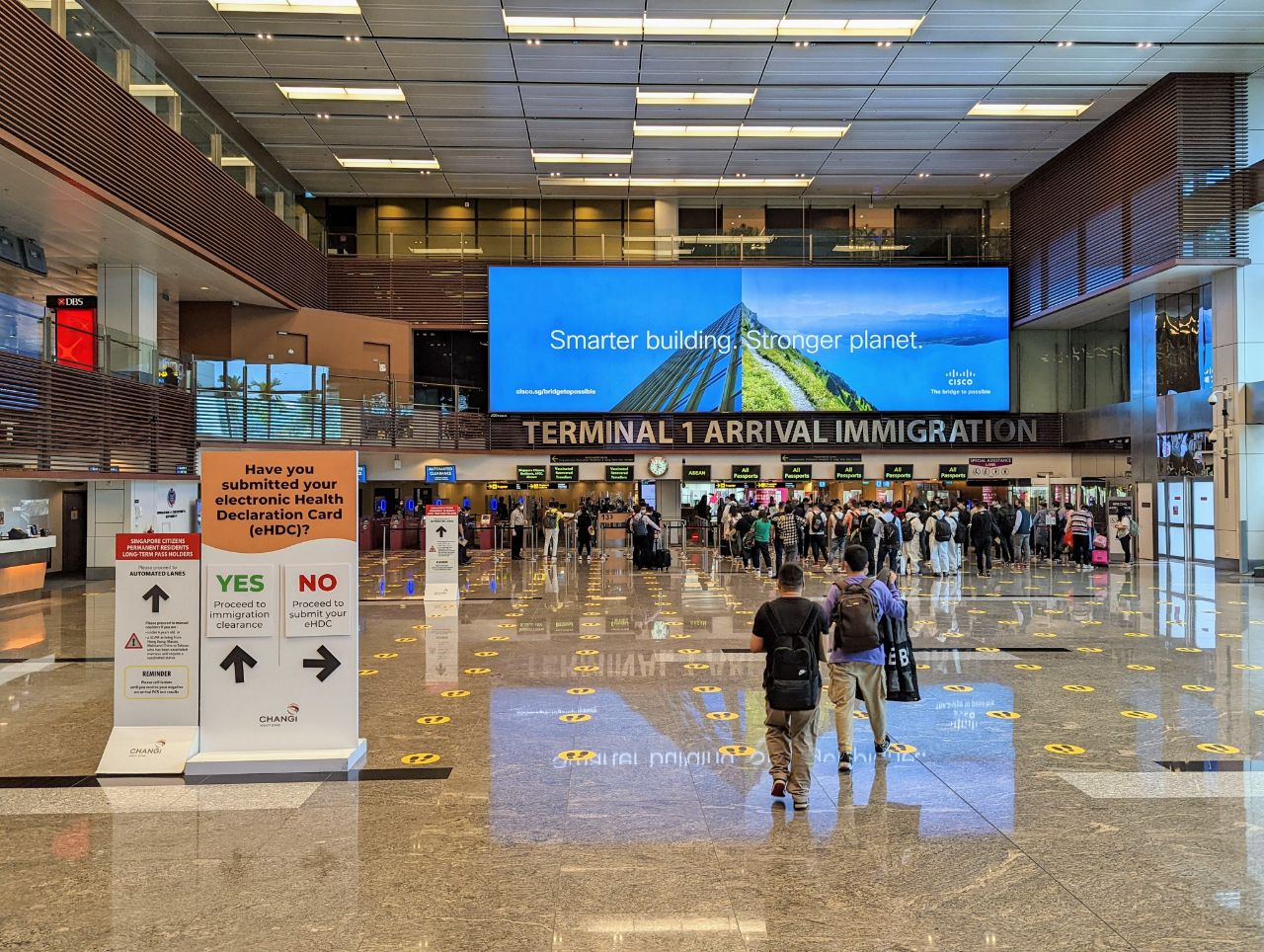About a week ago, MOH announced that travellers to Singapore could now satisfy the pre-departure test requirement by taking a remotely-supervised tele-ART.
Well, actually they didn’t.
The cat was let out of the bag by Raffles Connect, which pushed an update to their app stating that travellers with a “residency document issued by Singapore” could take an overseas virtually-supervised ART when returning from Australia, India, the EU and United States.
One day later, the ICA’s website was updated to include “self-administered and remotely-supervised ARTs” as an acceptable pre-departure test for VTL and non-VTL travellers. Crucially, it didn’t state any geographical restrictions nor residency requirements- suggesting that this option would indeed be available to all travellers.

But then the next day brought another twist. ICA’s website was updated again with an MOH circular that featured a list of 42 eligible countries, and limited overseas tele-ARTs to Singapore Citizens, Permanent Residents and Work Pass Holders.

And yet this raised more questions than answers. People were quick to point out strange omissions: while all of Singapore’s European VTL partners were approved, Switzerland was not. MOH had bothered to include Iran and Yemen, but not Turkey. Most of the Scandinavian countries were present, but there was no room for Iceland or Norway. And there wasn’t a single Southeast or East Asian country to be found.
Some of these issues were addressed in yet another update yesterday, but this botched rollout, in a way, is emblematic for Singapore’s approach to overseas tele-ARTs.
It should have been a major fillip for travellers, with more convenient testing dovetailing nicely with the dramatic simplification of travel restrictions under the upcoming Vaccinated Travel Framework. It’d be a way of saying “look, we’re not throwing caution to the wind entirely, but we’re going to make it as simple as possible for you to comply with the regulations”.
Instead, the way it’s been gone about has only added further confusion and complication, at a time when we should be turning towards clarity and conciseness.
Singapore’s current pre-departure testing rules

To recap, travellers to Singapore must take a COVID-19 test within two days before departure, which can be:
- a PCR test
- a professionally-administered ART
- a self-administered ART, remotely supervised by an approved provider
Option (3) is only available to travellers who are:
- Singapore Citizens, Permanent Residents, Long Term Pass Holders or Work Pass Holders
- physically present in an approved country
- using an approved ART provider in Singapore
Now, I can understand why the ART provider must be in Singapore. That’s sensible, because it allows the MOH to exercise some degree of oversight over the process, with regulated and vetted providers.
What is much harder to understand is why the restriction on countries, or types of travellers.
Why these countries?
MOH has published a document with a delightfully long name that should itself hint at the amount of red tape we’re dealing with.
List of Approved Providers for Antigen Rapid Testing for Real-time Remote Supervised Self-Swab to Fulfil Pre-Departure Testing Requirements involving Singapore Citizens, Permanent Residents and Work Pass Holders (including Long Term Pass Holders) situated overseas.
Inside this treatise (because that’s all it can be described as, really) you’ll find the list of countries where eligible travellers can take remotely-supervised tele-ARTs before coming to Singapore.
| 🌎 Eligible Countries for Tele-ART | |
|
|
The first question a list like this begs is: why these countries and not others? Is there really a material difference between a tele-swab in Tehran versus Bangkok, when in both cases the supervisor sits in Singapore?
It certainly can’t be health risks. The entire premise of reopening our borders is that risks around the world have been harmonised, and you’re just as likely to import a COVID case from Australia as you are Afghanistan.
Only MOH knows why there was a need to adopt a whitelist, rather than blacklist approach, and having just removed a huge chunk of complexity with the sunsetting of VTLs, why are we backsliding again?
Second, notice the names in bold? Those weren’t on the original list of approved countries, and were only added yesterday.
This bug fix, if you will, was clearly meant to address some of the incongruence with the original list:
- Switzerland and Turkey were obvious oversights- if you’re going to include all of Western Europe and the Middle East, there’s no reason why they should be absent
- Adding Andorra, Iceland, Liechtenstein, Monaco, Norway and the Vatican would bring this list in line with Singapore’s policy of treating the EEA and European microstates as a single VTL zone
- Adding Canada was, well, how can you have America without America Junior?
But if we’re going to play it this way, then we should be calling up city hall demanding the inclusion of San Marino too. You know, that enclave entirely within Italy, famous for Mount Titano, Borgo Maggiore, and stumping trivia night participants? I can’t believe we chose to exclude it, and I’m this close to starting a #justiceforsanmarino movement to protest our shoddy treatment.
Since it’s not always clear over the interwebs, I should probably state that I’m being facetious. Of course it’s ludicrous to split hairs over a microstate you could drive through in 20 minutes. But that’s exactly what we’re doing with our current approach.
If we’re deciding to be so granular by listing the Vatican City just so people know they can swab their noses during an audience with the pope, we’re basically living out the No U-turn Syndrome coined by Sim Wong Hoo:
In the US, when there is no sign on the road, it means that you can make a U-turn. When the authorities do not want people to make U-turns, they will put up signs to tell you not to make U-turns.
In Singapore, it is the reverse. When there is no sign on the road, you are not allowed to make U-turns. When the authorities allow you to make U-turns, then they will put up signs to give you that right.
This completely goes against the grain of opening up, and gives rise to all sorts of hypothetical questions that frankly, would have been easy to avoid. Since the USA is on the list, can I do my test from Guam? Since Denmark is there, can I ART from Greenland? Oh nice, Netherlands is featured. Aruba and Sint Maarten can? What’s internet connectivity on the Isle of Man like? It sounds absurd- and it should – but that’s what lists like these foster.
What bothers me more is that I can just picture some bureaucrat reading this and not thinking “oh yeah, it’s a bit silly that we’re making such minute distinctions”, but rather “oh yeah, we missed out San Marino. Never mind, publish a new list next week.”
And then next week a new document is published with even more footnotes. We’re supposed to be simplifying things, not making them more complex!
Why these travellers?
Even if we buy the argument that tele-ARTs are somehow more valid for travellers returning from some countries than others, it still doesn’t explain why the option is only available to Singapore residents.
Does a US resident planning to visit Singapore for a vacation really present a more risky proposition than a returning Singaporean who spent two weeks over there? If not, why do the regulations suggest that’s the case?
All this does is create more work for the check-in agents, which means longer wait times for everyone, Singapore resident or not.
Is it a Singapore restriction?
Now, I’ve seen it suggested that the restriction is not imposed by Singapore, but by other countries. For example, Country X may not allow overseas tele-medicine providers to service people within its borders, so we can’t add it until Singapore and Country X work out an arrangement.
Leaving aside that I find it hard to believe Singapore bothered contacting the Yemeni government to coordinate something, I don’t think this is the case for two reasons.
The first is that I’ve spoken to people in the industry, who tell me the restriction is on our side, not overseas.
The second is empirical observation. You can find a ton of tele-medicine providers in the USA and Canada (e.g. Canadian Travel Clinics, Qured) that sell travellers an ART kit that they bring with them on their trip. When returning to the USA or Canada, they book a video appointment from wherever they are, do a supervised test, and get their pre-departure test certificate emailed to them.
If these providers can offer their services anywhere in the world, why not Singapore-based ones? Remember: Singapore controls pre-departure testing rules for travelling to Singapore, not anyone else.
Conclusion
I’ll readily admit there may be be other factors at play here that I’m unaware of, and if so then fine, I’ll have egg on my face. But you know what? I’d actually feel more relieved than anything, because at least there’d be some rationale as to why these countries and these travellers and not those countries and those travellers.
As it is, the optics look bad, like another classic case of an overcautious approach coupled with an unhealthy obsession with red tape, which I thought we’d laid to rest with the retirement of the VTLs.
Tele-ARTs are a fantastic innovation that simplify travel tremendously, but we defeat the purpose if we create so much uncertainity about who can use it. It could very well become a moot point in a few weeks, if Singapore does indeed scrap pre-departure testing as rumoured, but until then it’s an unwelcome reminder of a penchant for bright line rules.
What’s interesting to me is that the Straits Times, in their article about remote tele-ARTs, mentioned the following:
The Straits Times (ST) has contacted MOH for more details on how countries are deemed to be eligible for the scheme.
Till today, they haven’t received an answer.
I think that says a lot.









Any chance that the PDT required to Singapore will be scrapped before May 22?
The MTF has mastered the art of coming up with unbelievably stupid rules.
Wouldn’t surprise me if the reason for only allowing SC/PR/LTPH is that they want to avoid people from all over the world using SG video providers for their testing needs to unrelated 3th countries.
Hard to fully verify intention of flying to Singapore otherwise. E-tickets can be cancelled/voided after all.
In theory they could print on the test results that it’s only valid for entering Singapore, but then it would give issues if someone wants to use the test to transit elsewhere on the way to Singapore (e.g. MEX-LAX-SIN).
But if people want to use an sg video provider to travel elsewhere, it’s their own issue whether or not it’s accepted. Moreover Singapore is an unlikely source they’d look, they’re much more likely to looking for usa or some other country.
In places like Helsinki the cheapest ART test costs 79€.
If SG would openly allow anyone worldwide to use SG providers for travel ART’s, this would make it too attractive to many. Could also overwhelm the providers.
In the end the SG ART certificates are sort of a grey area as they don’t fully mention the test was only video supervised (last time I saw one).
Guess they in some way want to protect the integrity of the program.
I agree that however clumsy, the underlying intention is generally about preserving healthcare capacity – i.e. the capacity of local clinics to cater to ‘returning’ travellers.
i dont think it’s capacity- there is absolutely no risk of people from 3rd countries clogging up Singapore ART providers. who would risk showing up at check-in with a document issued by a singapore clinic, when flying from germany to the USA? there are many other tele-medicine providers in other countries, which would be more natural choices and even then, clinics are free to set how many slots they want to open. if they set 50 per day and all 50 are taken up, so be it. it’s hardly going to stress them even more, this is a paid commercial… Read more »
What other countries would even accept these video tests for pre departure tests? Although USA accepts certain video tests for the pre departure test I don’t think any test by a Singapore provider would meet the CDC requirements which require the test be administered by the manufacturer https://www.cdc.gov/coronavirus/2019-ncov/travelers/testing-international-air-travelers.html
Last time I saw one, the test certificate looked (almost) the same as an in-person conducted ART test in Singapore, and doesn’t mention the test was only video supervised.
That’s why it’s a (very) grey area.
People use them now already to travel from Singapore to everywhere that accepts ART.
Seems clearly forbidden “The Real-time Remote Supervised Self-Swab ART result should only be used for fulfilling the Pre-Departure Test (PDT) requirement for travel to Singapore.1” https://www.moh.gov.sg/docs/librariesprovider5/default-document-library/list-of-approved-art-providers-for-remote-supervised-self-swab-for-overseas-travellers-(28032022)5f6a1f6868cb460c821da80c1d42b8b4.pdf although maybe some people will try and use it for other purposes. I think if the test is conducted within Singapore there may be different rules and some countries would accept it as a PDT although seems unlikely it would meet the CDC requirements.
One thing that I think may be the issue (though I’d be happy to be proven wrong), is that some countries might consider this to be “practicing medicine without a liscence” in their country. For example, a Singapore doctor cannot just show up in the US and work as a doctor. So I wonder if, say, regulatory authorities there might consider providing an ART to someone in the US as illegally practicing medicine (I note that the US is particularly strict on this; before the pandemic a doctor in one state cannot provide tele health services in another. This was… Read more »
Tbh this is all the same problems with VTL. Nothing’s new. Nitpickicking the details, missing the birds for the bees. Stupid whitelists that barely make sense. Remember those people who went to Rome and technically not allowed to visit Vatican City if they wanted to be compliant with VTL. Even worse, instead of turning a blind eye about it given how stoopid it was, ICA went and explicitly added a footnote under Italy saying that Vatican City was definitely not part of Italy and therefore not VTL. Like it’s one thing to be stoopid, it’s another to shout from the… Read more »
Never underestimate the stupidity of haggling, sleep-deprived bureaucrats.
You can always count on these supposedly highly intelligent government funded scholars turned bureaucrats to justify their positions by eithering coining meaningless terms like “national posture”, and overthinking and complexifying things that even OYK will, at some future press conference, says need revamping because all the add-on bits and pieces have “become alphabet soup” (his actual words).
Beautiful treatise. Bravo. Hopefully someone high up will read it and do the right thing.
TBH this round is disappointing. PDT still stays which means SG just opened to what other countries were months ago and they are now done with the PDT thing entirely
I’m not even looking so far afield. What does this mean for air travel between SG & MY? Previously with the vtl, pre-departure art test supervised by provider in Malaysia (CLEA) was accepted. So now, with no vtl, it is no longer accepted? And even a SG tele- art is not accepted as MY is not in the list of approved countries? So strange….
yeah CLEA is another confusing one. there have never been any issues with acceptance during the VTL days, and I don’t see why that will change when VTF starts. which basically means in this case you can use a tele-art provider in the country of departure, but not singapore…make of that what you will.
See, the situation with CLEA is a bit “unique”, because the test, from the authorities point of view, does not have any obvious “signs” that it’s a tele-ART test. For all intents and purposes, the report you get from doing a CLEA test looks exactly like that of any other professionally administered ART test in Malaysia. It appears to be issued by a standard clinic, and it includes all the required information. Nothing on the report implies that it was a tele-ART test. As long as CLEA’s report remains this way, I see no reason it will suddenly be deemed… Read more »
Even though your posts like this are nothing more than rants, I really love them, because I share your sentiments 100% and I love how you break it down and analyse it from numerous angles.
Teleart of positive test is not acceptable to document recovered traveler exemption of testing. My friend was denied boarding on scoot yesterday from Sydney because the positive teleart he had from 2 weeks ago was not accepted. He had to get an art test at the airport and take a later flight.